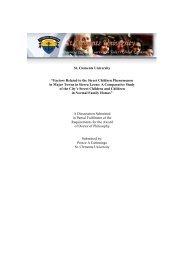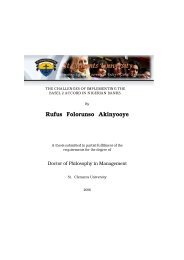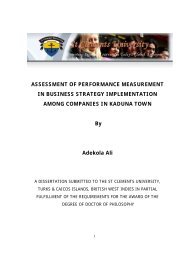The role of informal microfinance institutions in saving
The role of informal microfinance institutions in saving
The role of informal microfinance institutions in saving
Create successful ePaper yourself
Turn your PDF publications into a flip-book with our unique Google optimized e-Paper software.
parts <strong>of</strong> Tanzania. <strong>The</strong>y are member driven and democratically organized. SACCOs have<br />
developed and become a tool for mobiliz<strong>in</strong>g and <strong>in</strong>creas<strong>in</strong>g sav<strong>in</strong>gs <strong>in</strong> Tanzania which can be<br />
improved to become a susta<strong>in</strong>able part <strong>of</strong> Tanzania f<strong>in</strong>ancial development.<br />
Although the Government formulated the SACCOs as a basis <strong>of</strong> poverty reduction <strong>in</strong> the<br />
rural/urban areas hav<strong>in</strong>g low <strong>in</strong>come households, and they have encountered various<br />
problems such as: SACCOs face short <strong>of</strong> funds for necessary <strong>in</strong>vestments <strong>in</strong> education and<br />
technological resources such as computers, build<strong>in</strong>g <strong>of</strong>fices, knowledge <strong>in</strong> operation the<br />
SACCOs and f<strong>in</strong>anc<strong>in</strong>g sav<strong>in</strong>gs differs among SACCOs. Poor <strong>in</strong>ternal control which is a result <strong>of</strong><br />
the system failure to prevent and detect fraud or error, corruption and nepotism caused by<br />
grant<strong>in</strong>g loans to unworthy borrowers, risky <strong>in</strong>vestment done without mak<strong>in</strong>g the fully<br />
required analysis, lack <strong>of</strong> tra<strong>in</strong><strong>in</strong>g amongst the members and the Board <strong>of</strong> Directors and lack <strong>of</strong><br />
the decentralized f<strong>in</strong>ancial system which can provide f<strong>in</strong>ancial services to the SACCOs.<br />
1.1.1. FACTORS LIMITING INDIGENEOUS HAVING LOW HOUSEHOLDS TO GET CREDIT<br />
FROM FORMAL FINANCIAL INSTITUTIONS IN TANZANIA IN THE POST 1990 PERIOD.<br />
This is the period when the government had implemented economic reforms <strong>in</strong> the country.<br />
This among others led to the restructur<strong>in</strong>g and privatization <strong>of</strong> most state owned f<strong>in</strong>ancial<br />
<strong>in</strong>stitution. However, while this <strong>in</strong>creased efficiency and competition <strong>in</strong> the f<strong>in</strong>ancial sector, it<br />
had detrimental effects to the provision <strong>of</strong> credits to small and medium sizes enterprises (which<br />
are owned by local people) compared to the pre 1990 period. <strong>The</strong>se factors that have made<br />
commercial banks to hesitate to provide credits to <strong>in</strong>digenous owned small and medium size<br />
entrepreneurs <strong>in</strong> the post reform period are:<br />
1: Lack or <strong>in</strong>adequate collateral securities demanded by banks. Most small and medium<br />
sizes local entrepreneurs do not have the type <strong>of</strong> collaterals demanded by banks as one<br />
<strong>of</strong> the conditions <strong>of</strong> gett<strong>in</strong>g loans. Plans to allow land title to be regarded as collateral<br />
may help to reduce such a problem.<br />
2. Some banks have been restrict<strong>in</strong>g lend<strong>in</strong>g operations while giv<strong>in</strong>g more priority to<br />
loan recovery.<br />
23
















